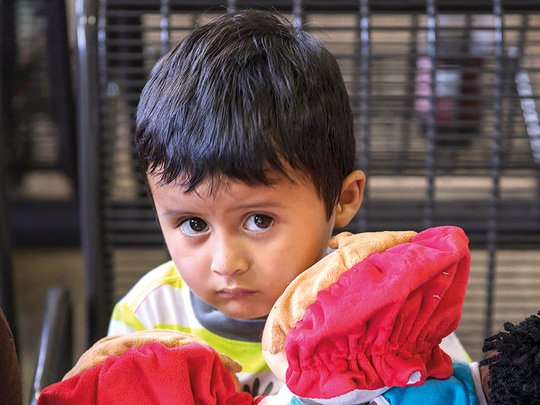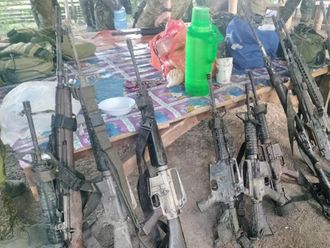
Do not misbehave. Do not sit on the floor. Do not share your food. Do not use nicknames. Also, it is best not to cry. Doing so might hurt your case.
Lights out by 9 pm. Lights on at dawn, after which you make your bed according to the step-by-step instructions posted on the wall.
Wash and mop the bathroom, scrub the sinks and toilets.
Then form a line for the walk to breakfast.
These are some of the daily rituals of the more than 2, 800 children who have been forcibly separated from their undocumented immigrant parents in the US and who were sent to holding facilities, sometimes hundreds or thousands of miles from where their parents were being held for criminal prosecution.
Last week, in trying to comply with a court order, the US government returned slightly more than half the 103 children under the age of 5 to their migrant parents.
But more than 2,800 children - some of them separated from their parents, some of them classified at the border as “unaccompanied minors” - remain in these facilities, where the environments range from impersonally austere to nearly bucolic, save for the fact that the children are formidably discouraged from leaving and their parents or guardians are nowhere in sight.
Depending on several variables, including happenstance, a child might be sent to a 33-acre youth shelter in Yonkers, New York, that features picnic tables, sports fields and even an outdoor pool. “Like summer camp,” said Rep. Eliot L. Engel, Democrat-New York., who recently visited the campus.
Or that child could wind up at a converted motel along a tired Tucson, Arizona, strip of discount stores, gas stations and budget motels. Recreation takes place in a grassless compound, and the old motel’s damaged swimming pool is covered up.
Still, some elements of these detention centres seem universally shared, whether they are in northern Illinois or South Texas. The multiple rules. The wake-up calls and the lights-out calls. The several hours of schooling every day, which might include a civics class in American history and laws, though not necessarily the ones that led to their incarceration.
Most of all, these facilities are united by a collective sense of aching uncertainty - scores of children gathered under a roof who have no idea when they will see their parents again.
Letitia
“You had to get in line for everything,” recalled Leticia, a girl from Guatemala.
Small, slight and with long black hair, Leticia was separated from her mother after they illegally crossed the border in late May. She was sent to a shelter in South Texas - one of more than 100 government-contracted detention facilities for migrant children around the country that are a rough blend of boarding school, day care centre and medium security lockup. They are reserved for the likes of Leticia, 12, and her brother, Walter, 10.
The facility’s list of no-no’s also included this: Do not touch another child, even if that child is your hermanito or hermanita - your little brother or sister.
Leticia had hoped to give her little brother a reassuring hug. But “they told me I couldn’t touch him,” she recalled.
Leticia wrote letters from the shelter in South Texas to her mother, who was being held in Arizona, to tell her how much she missed her.
She kept the letters safe in a folder for the day when she and her mother would be reunited, though that still hasn’t happened.
No Touching, No Running
Diego Magalhes, a Brazilian boy, spent 43 days in a Chicago facility after being separated from his mother, Sirley Paixao, when they crossed the border in late May. He did not cry, just as he had promised her when they parted. He was proud of this. He is 10.
He spent the first night on the floor of a processing centre with other children, then boarded an airplane the next day. “I thought they were taking me to see my mother,” he said. He was wrong.
Once in Chicago, he was handed new clothes that he likened to a uniform: shirts, two pairs of shorts, a sweatsuit, boxers and some items for hygiene. He was then assigned to a room with three other boys, including Diogo, 9, and Leonardo, 10, both from Brazil.
The three became fast friends, going to class together, playing lots of soccer and earning “big brother” status for being good role models for younger children. They were rewarded the privilege of playing video games.
There were rules. You couldn’t touch others. You couldn’t run. You had to wake up at 6:30 on weekdays, with the staff making banging noises until you got out of bed.
“You had to clean the bathroom,” Diego said. “I scrubbed the bathroom. We had to remove the trash bag full of dirty toilet paper. Everyone had to do it.”
Diego managed to stay calm, in part because he had promised his mother he would. Last week, a federal judge in Chicago ordered that Diego be reunited with his family. Before he left, he made time to say goodbye to Leonardo.
“We said ‘Ciao, good luck,” Diego recalled. “Have a good life.”
But because of the rules, the two boys did not hug.
Mischief and Melancholy
The kids are just - kids. That is what it comes down to, according to an employee at Casa Padre, a shelter for 1,500 migrant boys that inhabits a former Walmart Supercenter in Brownsville, Texas, close to the Mexican border. Just kids, all being held in the custody of the US government.
Take the mooing, for example. The walls that separate the sleeping quarters do not reach the high ceilings, which means that sounds travel in the yawning spaces within the 250,000-square-foot building. One boy will make a loud animal noise, after which another will emit an animal-like response.
“Someone will start mooing,” the employee said. “They just think it’s funny. They just do it long enough so everyone can hear, and then we all start laughing.”
Casa Padre is run by Southwest Key Programs, one of the largest migrant youth shelter operators in the country. According to the employee, its staff is overworked and a little stressed out by the 12-hour shifts and the considerable responsibilities.
A 15-year-old boy from Honduras recently escaped by climbing a fence during an outdoor recreation period. Staff members conduct round-the-clock head counts, sometimes at 15-minute intervals, all while monitoring the constant flow of boys being received and discharged.
Some of the boys at Casa Padre were separated from their parents at the border, but most were caught crossing without a parent or guardian.
Some time in the evening is set aside for prayer. After that, many focus on creating intricately designed bracelets. The bracelets become gifts, keepsakes, something to remember someone by.
Lights out at 9pm.












